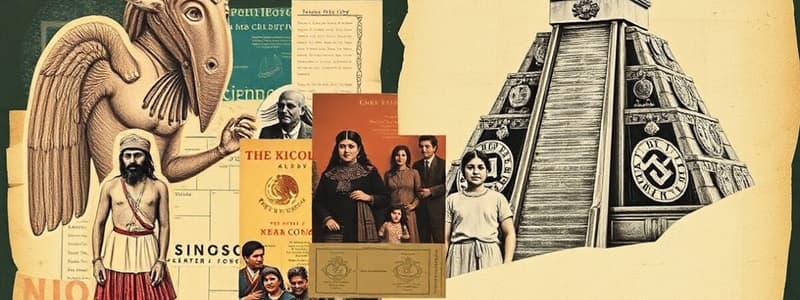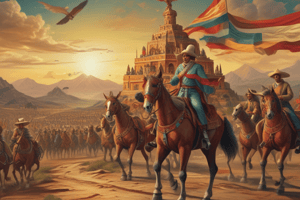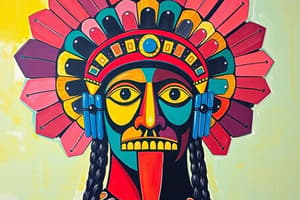Podcast
Questions and Answers
What influenced Mexican society for nearly three hundred years?
What influenced Mexican society for nearly three hundred years?
- Indigenous customs
- Spanish colonialism (correct)
- Olmec art
- Aztec religion
All Mexicans are of indigenous ancestry.
All Mexicans are of indigenous ancestry.
False (B)
What characterized the social structure of early Mexican societies?
What characterized the social structure of early Mexican societies?
hierarchical
The Olmecs were known for their fine art and their inventions influenced later ________ in the region.
The Olmecs were known for their fine art and their inventions influenced later ________ in the region.
Match the following groups with their characteristics:
Match the following groups with their characteristics:
What percentage of the indigenous population was killed during the smallpox outbreak?
What percentage of the indigenous population was killed during the smallpox outbreak?
The Aztec empire became more stable after the death of Moctezuma.
The Aztec empire became more stable after the death of Moctezuma.
What factor may have contributed to Moctezuma allowing the Spanish to enter Tenochtitlán?
What factor may have contributed to Moctezuma allowing the Spanish to enter Tenochtitlán?
In what year did the Spanish and their allies return to Tenochtitlán?
In what year did the Spanish and their allies return to Tenochtitlán?
The Aztecs ruled their conquered groups directly through governance.
The Aztecs ruled their conquered groups directly through governance.
The Spanish designed plans to surround Tenochtitlán and _______ it from the outside.
The Spanish designed plans to surround Tenochtitlán and _______ it from the outside.
What happened to the Aztec nobles during the Spanish conquest in 1520?
What happened to the Aztec nobles during the Spanish conquest in 1520?
Match the following events with their descriptions:
Match the following events with their descriptions:
Tenochtitlán fell to the Spanish and their allies in _____ 1521.
Tenochtitlán fell to the Spanish and their allies in _____ 1521.
Match the following historical events with their corresponding details:
Match the following historical events with their corresponding details:
Flashcards
Maya Civilization
Maya Civilization
The Mayas built large stone structures like pyramids and temples, and had an advanced calendar system.
Olmec civilization
Olmec civilization
The Olmecs were known for their art and influence on later societies in Mexico.
Mexican society's diversity
Mexican society's diversity
Mexico has a diverse population, including indigenous and European ancestry (mestizo).
Spanish influence in Mexico
Spanish influence in Mexico
Signup and view all the flashcards
Early Mexican societies' complexity
Early Mexican societies' complexity
Signup and view all the flashcards
Aztec Rule
Aztec Rule
Signup and view all the flashcards
Moctezuma's Dilemma
Moctezuma's Dilemma
Signup and view all the flashcards
Spanish Brutality
Spanish Brutality
Signup and view all the flashcards
Tenochtitlán's Fall
Tenochtitlán's Fall
Signup and view all the flashcards
Tribute System
Tribute System
Signup and view all the flashcards
Spanish conquest of Tenochtitlan
Spanish conquest of Tenochtitlan
Signup and view all the flashcards
Factors weakening the Aztecs
Factors weakening the Aztecs
Signup and view all the flashcards
Impact of smallpox outbreak
Impact of smallpox outbreak
Signup and view all the flashcards
New society in colonial Mexico
New society in colonial Mexico
Signup and view all the flashcards
Influence of African culture
Influence of African culture
Signup and view all the flashcards
Study Notes
Mexico's Beginnings
- A plaque in Mexico City describes the painful creation of the mestizo nation of Mexico, resulting from the Spanish conquest of the Aztec Empire.
- Mexicans have a mix of pride in their indigenous heritage and acceptance of the Spanish influence.
- The Olmecs, a civilization predating the Aztecs, developed the first known writing system in the Western Hemisphere.
- The Olmecs created sophisticated art and monumental stone structures.
- The Mayans built city-states around 150 CE, primarily in what is today Guatemala. They built great cities and cultivated advanced agricultural systems.
- Teotihuacan, a city in the Valley of Mexico, was a major center of trade and cultural influence in the region before the Aztecs. It featured large pyramids.
- The Aztecs, located in the Valley of Mexico, constructed a significant and vast empire.
- Aztecs were skilled in cultivation and irrigation, and built huge cities. They also established a complex government as well as sophisticated trading systems.
- The Spanish conquest led to the mixing of indigenous and European cultures, creating the mestizo population.
Early Mexican Societies
- The region of present-day Mexico is geographically diverse.
- Sophisticated societies existed in central Mexico at the time of the Spanish arrival.
- The largest and most sophisticated of these societies were in what is now central Mexico and Central America.
- Central Mexico and Central America contained societies known for their advanced art, monumental architecture, and complex social structures.
The Spanish Conquest
- The Spanish monarchy commissioned explorers to find a faster route to Asia, leading to the discovery of the Americas.
- The Spanish established settlements in the Caribbean, enslaving indigenous peoples.
- Cortés led a Spanish expedition to Mexico in 1519, targeting the Aztec Empire.
- The Aztecs, though initially welcoming, were ultimately defeated.
- The Spanish benefited from alliances with other indigenous groups, advanced weaponry, as well as disease to overcome their enemies.
- Moctezuma initially welcomed Cortés, but internal conflict within the Aztecs contributed to their downfall.
- The conquistadors' motivation was primarily economic and political domination, with the intention of claiming land and resources for Spain.
- After the fall of Tenochtitlán, the Spanish established the colony of New Spain.
- Spanish colonization heavily impacted indigenous populations through disease, forced labor, and cultural assimilation.
Colonial Mexico
- Mexico City was built on the ruins of Tenochtitlán.
- Spain developed a complex system of governance and trade.
- Indigenous populations were generally forced into labor roles beneath the Spanish system.
- The Catholic Church played a significant role in colonial society, providing education and shaping religious practices.
- The economy was based on resource extraction (gold and silver) for the benefit of Spain and the growth of colonial power.
- The economy was characterized by trade with Spain, exporting raw materials and importing manufactured goods.
Mexican Independence
- Events in Europe, including the French invasion of Spain, influenced the desire for independence in New Spain.
- Miguel Hidalgo's uprising triggered revolt but was ultimately suppressed.
- José María Morelos continued the revolutionary movements.
- Criollo elites formed plans to preserve privileges and establish self-governance.
- Mexico gained independence in 1821; the new nation faced political and economic challenges.
Aftermath of Independence
- Mexico's leaders struggled to establish political stability, and faced internal conflicts.
- The loss of territory to the United States exacerbated existing challenges.
- Mexico suffered from political instability and the legacy of Spanish colonialism.
- The war with the U.S. resulted in a significant loss of territory for Mexico.
Studying That Suits You
Use AI to generate personalized quizzes and flashcards to suit your learning preferences.




